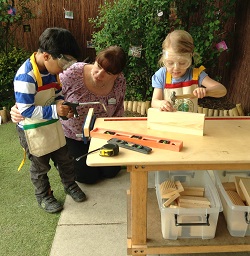How Good Is Wood?
M&D
 It may not seem obvious, but woodwork is a perfect activity where boys and girls from age three can learn effectively. Benefits include physical development as muscles become stronger when children vary the force they use and development of hand-eye coordination. Fine motor control is needed to hold nails in place. Personal, social and emotional development is supported as children demonstrate deep levels of involvement when undertaking woodwork: perhaps because it seems a ‘real’ task and is truly challenging. They develop problem solving abilities which can carry over into real-life situations. Children discuss the rules and safety, enhancing communication and language development. Those who usually find it hard to conform manage to comply with boundaries as they are so keen to take part. Self-esteem is boosted as children feel pride in their hard-won achievements.
It may not seem obvious, but woodwork is a perfect activity where boys and girls from age three can learn effectively. Benefits include physical development as muscles become stronger when children vary the force they use and development of hand-eye coordination. Fine motor control is needed to hold nails in place. Personal, social and emotional development is supported as children demonstrate deep levels of involvement when undertaking woodwork: perhaps because it seems a ‘real’ task and is truly challenging. They develop problem solving abilities which can carry over into real-life situations. Children discuss the rules and safety, enhancing communication and language development. Those who usually find it hard to conform manage to comply with boundaries as they are so keen to take part. Self-esteem is boosted as children feel pride in their hard-won achievements.
Isn’t it too dangerous?
Adults may think of woodwork as too risky an activity – and it is risky. But the learning benefits are great and the risks can be managed. Children actually need risk in play. “Children who are not exposed to risk nor given opportunities to test their boundaries will be incapable of taking risk”, says Henrik Neegard, a Norwegian expert and author on outdoor play in the early years. “Overprotecting children can produce anxious children who don’t know how to deal with their surrounding environment.” He goes on to say that educators should take a balanced view on the benefits versus the risk.
In a childcare setting, it is often too easy to say ‘no’ to risky activities for fear of how parents will react if something goes wrong. But accidents and mistakes do happen during any play; if everyone is fully informed of the benefits of such an activity, a full risk assessment is completed with sound procedures and close supervision for managing the risk, challenging activities shouldn’t be ignored. We should be providing opportunities for all children to encounter or create uncertainty, unpredictability, and potential hazards as part of their play, so children learn to weigh up risk for themselves. It does not mean putting children in danger of serious harm.
So how should we manage risk when allowing young children to engage in woodwork? Close supervision and guidance of children when first using tools will help to avoid injury through misuse. Any children with behavioural difficulties or developmental delay may need ongoing close supervision. Children can be taught how to avoid hitting their fingers with a hammer by showing them firstly how to hold the hammer at the end, with all fingers wrapped around it, and then to tap lightly at first then move their fingers away as they hit harder. Children should wear goggles to avoid sawdust in their eyes. There should be strict rules minimising the number of children at and near the workbench and near it at any time to avoid any accidents from moving tools. Children should be shown how to use sandpaper to avoid splinters, how to hammer down nails properly to avoid protruding nails, and informed about why nails should never be removed from the work area. When using a saw, the wood should first be firmly and slowly gripped in the vice and two hands must be used to hold the saw, keep it in a straight line and don’t press too hard – let the saw do the work.
Remember, young children will often make up their design as they go along: it’s the process of learning that’s important here, not the end result.
Every child is different and one child’s idea of a risky situation might be another’s idea of something easy-peasy. Children shouldn’t be forced to do anything that they feel is beyond them, or encouraged to go any further than they feel safe. Wait until a child voluntarily approaches the workbench, and then take it from there.
What about the girls?
There is no reason why woodwork should be aimed particularly at boys – girls should be equally encouraged to take part. If, however, girls seem to be reluctant to participate there are ways to entice them to the woodworking area. Try having a ‘girls only’ day and display images where women are depicted as construction workers. Woodwork topics such as constructing a fairy house, castles or a minibeast hotel may also inspire girls. As a rule, if the activity is presented in a non-specific gender way, girls are only too happy to participate. “Woodwork provides an excellent strategy for creating an inclusive, non-sexist and fulfilling environment that invites each and every child to be successful.”*
* Huber, 1999, ‘Woodwork with young children – you can do it!’







What an interesting article. I was first introduced to woodwork at secondary school, aged 12. Along with several other girls, I managed to slice open a finger – very badly. If I had started a little younger at the same time as the boys, I am sure the accident could have been avoided.